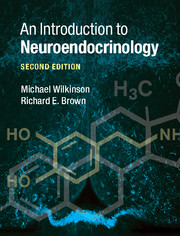Book contents
- Frontmatter
- Dedication
- Contents
- Preface to the second edition
- Acknowledgements
- List of abbreviations
- 1 Classification of chemical messengers
- 2 The endocrine glands and their hormones
- 3 The pituitary gland and its hormones
- 4 The hypothalamic hormones
- 5 Neurotransmitters
- 6 Neurotransmitter and neuropeptide control of hypothalamic, pituitary and other hormones
- 7 Regulation of hormone synthesis, storage, release, transport and deactivation
- 8 Regulation of hormone levels in the bloodstream
- 9 Steroid and thyroid hormone receptors
- 10 Receptors for peptide hormones, neuropeptides and neurotransmitters
- 11 Neuropeptides I: classification, synthesis and co-localization with classical neurotransmitters
- 12 Neuropeptides II: function
- 13 Cytokines and the interaction between the neuroendocrine and immune systems
- 14 Methods for the study of behavioral neuroendocrinology
- 15 An overview of behavioral neuroendocrinology: present, past and future
- Index
- References
6 - Neurotransmitter and neuropeptide control of hypothalamic, pituitary and other hormones
Published online by Cambridge University Press: 05 June 2015
- Frontmatter
- Dedication
- Contents
- Preface to the second edition
- Acknowledgements
- List of abbreviations
- 1 Classification of chemical messengers
- 2 The endocrine glands and their hormones
- 3 The pituitary gland and its hormones
- 4 The hypothalamic hormones
- 5 Neurotransmitters
- 6 Neurotransmitter and neuropeptide control of hypothalamic, pituitary and other hormones
- 7 Regulation of hormone synthesis, storage, release, transport and deactivation
- 8 Regulation of hormone levels in the bloodstream
- 9 Steroid and thyroid hormone receptors
- 10 Receptors for peptide hormones, neuropeptides and neurotransmitters
- 11 Neuropeptides I: classification, synthesis and co-localization with classical neurotransmitters
- 12 Neuropeptides II: function
- 13 Cytokines and the interaction between the neuroendocrine and immune systems
- 14 Methods for the study of behavioral neuroendocrinology
- 15 An overview of behavioral neuroendocrinology: present, past and future
- Index
- References
Summary
Previous chapters have discussed the endocrine glands and their hormones (Chapter 2), the hormones of the pituitary gland (Chapter 3), the hypothalamic hormones (Chapter 4) and neurotransmitters (Chapter 5). This chapter will describe how neurotransmitters influence the release of hypothalamic and pituitary hormones and the hormones of the adrenal medulla, pancreas, thymus and gastrointestinal tract. It will also examine the electrophy-siological properties of neurosecretory cells and the effects of drugs on the release of neurohormones.
The cascade of chemical messengers
As shown in Figure 6.1, and using the adrenal gland as an example, there is a cascade of chemical messengers that regulate target tissue function from the brain to the endocrine glands. For example, neurons release a neurotransmitter that regulates the secretion of neurohormones (such as CRH) from hypothalamic neurosecretory cells. These hypothalamic hormones stimulate the cells of the adenohypophysis (anterior pituitary) to synthesize and release their hormones. Many pituitary hormones, such as ACTH, act on endocrine target cells, such as the adrenal cortex, causing them to synthesize and release their own hormones (e.g. cortisol) which then stimulate biochemical changes in target cells elsewhere in the body, including the brain. In each step of this pathway, the individual neurotransmitters and peptide hormones bind to membrane receptors that activate a second messenger, such as cAMP, within the target cell (see Chapter 10). Steroid hormones (such as cortisol) act on receptors located inside the target cells (see Chapter 9). This chapter describes the effects of neurotransmitters on hypothalamic neurosecretory cells.
Neural control of hypothalamic neurosecretory cells
6.2.1 Neural input to the endocrine hypothalamus
Figure 4.1 illustrates the different nuclei of the hypothalamus, many of which have neurons, or nerve terminals, which release a variety of neurotransmitters including GABA, glutamate, kisspeptin, opioids, dopamine, norepinephrine and serotonin. These neurotransmitters all bind to receptors on hypothalamic neurosecretory cells. This chapter describes the magnocellular hypothalamic neurosecretory cells of the paraventricular and supraoptic nuclei (PVN and SON), whose axons terminate in the posterior pituitary, and the parvicellular hypothalamic neurosecretory cells, whose axons terminate in the median eminence (see Figure 3.1).
Information
- Type
- Chapter
- Information
- An Introduction to Neuroendocrinology , pp. 120 - 156Publisher: Cambridge University PressPrint publication year: 2015
